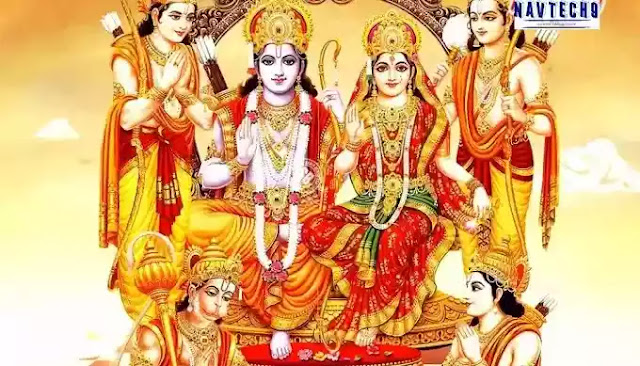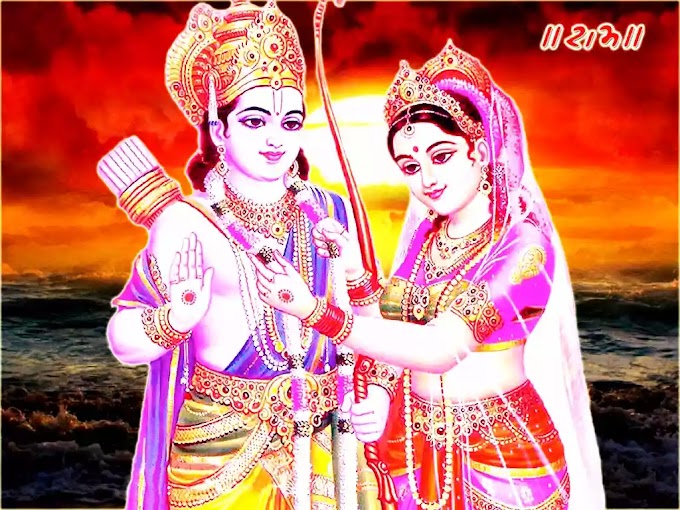How does Ram became god ?
Rama is the son of Dasaratha who is mostly recognized from Treta Yuga. He is the original man of Hindu culture.
Ram :
Lord Shri Ram Chandra is considered to be the greatest deity of Hinduism. According to the description in the Ramayana, King Dasaratha's wife was not having a son, then by eating the kheer in the form of prasad by the sage of the creation, he received the son of the sun.
Ram (Ramachandra) Nivas asthana Ayodhya, Vaikunthalok (Paramdham) Astradhanu (Kodand) Jeevan-sathi-Sitamata-Pitadasharatha (Father)
Kaushalya (Mother), mother of one mother, Lakshmana, Shatrughna be kush, Love .
Whom Hindu society knows by the name of Rama. The same Ram is further considered to be the best example of his personality, dignity, morality, humility, compassion, forgiveness, patience, sacrifice and valor. The life and might of Shri Ram is described as Ramayana, the Sanskrit epic composed by Maharishi Valmiki. The discovery of Sita in the Ramayana to refer to Sri Lanka's construction of a 25-kilometer stone bridge, called Ram Sethu, is still located today, which has been estimated approximately five thousand years ago by the help of carbon denting .
According to the belief, Goswami Tulsidas has also written the devotional well-known epic Ramcharitmanas centered on his life. Apart from these two, Ramayana compositions have also been made in other Indian languages, which are also quite famous. Especially in North India, Shri Rama is highly revered and an ideal man. They are also embellished with the term Purushottam. Maryada-Purushottam Rama was the eldest son of King Dasharatha of Ayodhya and Queen Kaushalya. Rama's wife's name was Sita, he had three brothers - Lakshmana, Bharata and Shatrughna. Hanuman is considered the greatest devotee of Rama. Rama killed Ravana, the king of Lanka (who had taken the path of unrighteousness). Shri Rama has a reputation as Maryada Purushottam. Shri Rama left the state, friends, parents, even wife to follow decorum. His family represents the ideal Indian family. Ram was born in Raghukul, whose tradition was that of Pran Jahun Baru Bachnu Na Jai . Rama's father Dasaratha gave his step mother Kaikeyi the promise (groom) to fulfill any of his two wishes. Kaikeyi came under the guise of maid Manthara as these vars asked King Dasaratha for his son Bharata for the throne of Ayodhya and fourteen years of exile for Rama. Rama happily accepted fourteen years of exile to protect his father's word. Wife Sita thought it appropriate to go to the forest with her husband, giving the example of the ideal wife. Bhai Laxman also spent fourteen years in the forest with Rama. Bharata rejects Mata's order for justice and goes to the elder brother Rama in the forest and brings his Charanpaduka (Khadoon). Then put it on the throne and ruled it. When Ram was a forest dweller, then his wife Sita took Ravana to Haran (Chura). In the forest, Rama found a friend and devotee like Hanuman who completed all of Rama's work. Rama sought Sita with the help of great men of the monkey caste like Hanuman, Sugriva etc. He reached Lanka by building a bridge over the sea and fought with Ravana. After killing him, Sita ji came back. After Rama returned to Ayodhya, Bharat handed over the kingdom to him. Ram was justice-loving. He ruled very well, that's why people still give good governance as the kingdom of Ram Rajya. His two sons Kush and Love took over their kingdoms. Many festivals of Vedic religion, such as Dussehra, Rama Navami and Deepavali, are associated with the forest story of Rama. In today's society, the increasing immorality, greed, falsity, robbery of the personality of Shriram's dignity, his moral conduct, his sacrifice, his truth, compassion, forgiveness, patience, valor, relevance is greatly increased. Always Satyam Shivam Sundaram will continue to act as a guide for life.
Name Etymology And Meaning
The word 'Rama' is derived from the sum of the suffix 'Gham' in 'Rama Dhatu'. 'Rama' is associated with the meaning of Rama (abode, vihara). They do 'Ramana' (abode) in the heart of the living beings, hence 'Ram' and devotees 'Ramana' (meditating) in them, so also they are 'Ram' - "Ramte kane kanne iti ramah". In his commentary on 'Vishnusahsrnama', Adya Shankaracharya gave the example of Padmapurana, saying that Yogijans do Ramana in the Lord of Nityananda, hence he is 'Rama'.
Antiquity In Avatar
Rama is not mentioned in Vedic literature in the prevailing form. The word 'Rama' is used only at two places in the Rigveda (10–3–3 and 10–73–14). One of them has been used in the meaning of black color (darkness of night) and the remaining one has been used in the sense of person ; But there is also no indication of him being the son of Avatari Purush or Dasaratha. Although Neelkanth Chaturdhar has chosen many of the mantras of the Rig Veda in his own discretion, he has given his Ramakathapak meaning, but this is his personal belief. The Ramakathaparaka meaning of those mantras has not been proved by any indication or any other commentary received in those cases of Rigveda itself. The word ‘Ikshvakuh’ (10–80–4) and ‘Dasharatha’ (1–126–4) have also been used at one place in the Rigveda. But there is no indication of his association with Rama.The word 'Rama' has been used in Brahmin literature at two sites in Aitareya Brahmana [10] (4-5-1 {= 4-27} and 4-5-7 {= 6-37}); But there he is called 'Ramo Margaveyaah', which according to Acharya Sayan is the son of a woman named 'Mrigavu'. At a place in Shatapatha Brahmin the word 'Ram' is used (6-7) - 1-7). Here 'Rama' is as the Acharya of the Yajna and he is called 'Rama Aupatapasvini'. This means that the incarnation of the prevailing Rama is due to the Valmiki Ramayana and Puranas .
Birth :
Rama's birth, from Akbar's RamayanaIn the most authentic text related to the story of Ramji, the following description is available in relation to the birth of Ramji in the Adikavya Valmiki Ramayana: -
...................... Chaitre Navami ke Tithou.
Constellation
Bhureeshu karkate lagne vakpavatinduna co.
That is, in the Navami Tithi of Chaitra month, in Punarvasu Nakshatra, when the five planets are in their high position and the position of Jupiter with the Moon in Cancer Ascendant (Ramji was born).
Here only the position of Jupiter and Moon are clear. Jupiter is exalted and the moon is self-possessed. Further in the fifteenth verse, the Sun is mentioned to be high. In this way, Jupiter and Sun are known to be high. Mercury is always near the Sun. Therefore, it is impossible for Buddha to be high (in Virgo) when the Sun is high (in Aries). In this way, the remaining three planets - Mars, Venus and Saturn are left to grow higher. For this reason, almost all scholars have considered the Sun, Mars, Jupiter, Venus and Saturn to be high in the time of Ramji's birth.
Modern study or research on the birth of Lord shree Rama :
Traditionally, Rama's birth is believed to be in Treta Yuga. According to the data available in Hindu theology, especially in mythological literature, a Chaturyugi has 43,20,000 years, of which Kaliyuga has 4,32,000 years and Dwapara 8,64,000 years. Rama was born in Treta Yug i.e. before Dwapara. Since Kali Yuga has just begun (around 5,500 years have passed) and Rama was born at the end of Treta and his present time on earth with the avatar has traditionally been considered as 11,000 years. Hence the Dwapara Yuga 8,64,000 years + 11,000 years of Rama's existence + 5,100 years since the end of Dwapara Yuga = 8,80,100 years in total. Hence traditionally Rama's birth is considered to be about 8,80,100 years ago.
Eminent Marathi researcher scholar Dr. Padmakar Vishnu Vartak has considered this time probable from a point of view. He says that the altitude of Vindhyachal and Himalayas at one place in the Valmiki Ramayana is said to be the same. The height of Vindhyachal is 5,000 feet and it is almost constant, while the height of the Himalayas is currently 29,029 feet and it is continuously growing. The height difference between the two is 24,029 feet. According to experts, the Himalaya grows 3 feet in 100 years. Therefore, it would have taken the Himalayas about 8,01,000 years to grow 24,029 feet. Hence, the height of the Himalayas must have been similar to that of Vindhyachal, about 8,01,000 years ago, which is mentioned in the present-day form in Valmiki Ramayana. In this way Dr. Vartak finds this time possible from a point of view, but he himself believes that he cannot confirm this time from any other source. Dr. Vartak in his well-known treatise 'Vaastav Ramayana' By doing the math mainly on the basis of the planets [16] according to the planetary position mentioned in the Valmiki Ramayana, the actual birth date of Rama is fixed on 4 December 7323 BC. According to him, on this date between 1:30 to 3:00 pm, Shri Ram must have been born.
After several years of research by Dr. P. V. Vartak (from 2004 AD) a research team of 'i-Serve' proved Ramji's birth on 10 January 5114 BC using 'Planetarium Gold' software . He believed that the planets had the same position on this date as described in the Valmiki Ramayana. But this time has become very suspicious. The 'Planetarium Gold' software used by the research team of 'i-Serve' is not really capable of doing true planetary arithmetic before 3000 BC. In fact before the year 2013 AD, such a planet- There was no available software capable of doing the math. In the planetary position obtained by this calculation, Saturn was in Scorpio, ie not in high (Libra). The moon was not in Punarvasu Nakshatra but was in the second phase of Pushya and the date was also Ashtami. Later in the correct calculation done by the software "ejplde431" by another .
Ramayan is based on Shree Ram's journey in treta yug .
To read more just click on :
If you have any question or suggestion about the article" shree Ram" then please mention it into the comments box .












1 Comments
Thank you for sharing about bhagwan rama ....
ReplyDelete